If your child is bored with training wheels and wants to learn to ride an adult bike, you likely have a number of concerns. However, as long as you keep safety and comfort in mind, teaching your kid to ride a bicycle can be a quick, painless process. Follow these helpful tips to best instruct your child how to push off, pedal, and cruise on his or her new "big kid" bike.
- Safety first. Before you do anything else, get your child properly fitted for the right bicycle helmet. Even if he or she already has a helmet, it’s very important to have one that fits properly and provides the adequate amount of protection for learning to ride a bike. You can do this at just about any bicycle supply shop or sporting goods store.
- Scout locations. When it comes to riding a bike for the first time, location is key. You want to find a flat, paved street or parking lot with no traffic or a low, gently sloping, grassy hill, depending on your child’s preference. Show him or her both areas and see which feels more comfortable.
- Prepare the bike. You can’t just remove your child’s training wheels and expect him or her to speed away. Take off the training wheels and then begin by removing the pedals and lower the seat. Begin by showing your child how to balance, brake, and turn on the bike with no pedals, and then put the pedals back on. This is the final stage, so get the camera ready!
How To: Ride a Bike [Real Simple]
How to Teach a Child to Ride a Bike [REI]
How to Lean to Ride a Bike in 15 Minutes [Better Homes & Gardens]
Teaching a Kid (and Adult) to Ride a Bicycle [iBike]
Teach Your Child to Ride a Bike [Disney Family]


![By Juliancolton (Own work) [Public domain], via Wikimedia Commons](http://respage.com/cms/img/2441.jpg)


 Equal Housing Opportunity
Equal Housing Opportunity